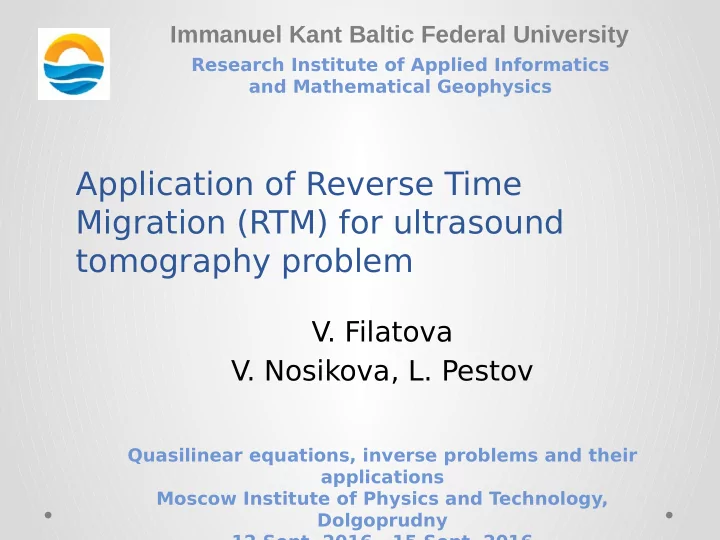

Immanuel Kant Baltic Federal University Research Institute of Applied Informatics and Mathematical Geophysics Application of Reverse Time Migration (RTM) for ultrasound tomography problem V. Filatova V. Nosikova, L. Pestov Quasilinear equations, inverse problems and their applications Moscow Institute of Physics and Technology, Dolgoprudny 12 Sept. 2016 - 15 Sept. 2016
Medical diagnostics One of the most important problems of medical diagnostics is the early detection of a variety of breast cancer tumors. X-ray tomography (CT) Mammography (also called mastography) Diagnostics Breast Cancer Magnetic resonance tomography (MRT ) Ultrasound examinations are relatively inexpensive, easy to use and safe diagnostic methods. Ultrasound imaging has great potential for the detection and diagnosis of breast cancer 2
Nowadays groups of scientists in Russia (MSU, chair of acoustics), in the USA (N. Duric, C. Li, P . Littrup, S. Schmindt, etc.) and in Germany (N. Ruiter, R. Dapp, M. Zapf, R. Jirik, etc) work on creation of models of the ultrasonic tomographs with high resolution and informative. However, one of the major problems is the development of efgective algorithms for measurements processing, i.e. numerical methods with high resolution for acoustics inverse problems. In order to obtain of the image of the speed of sound, we use RTM procedure (in the version [1]) for the ultrasound data. [1] D. Rocha, N. T anushev, P . Sava Acoustic wavefjeld imaging using the energy norm // 2015 SEG Annual Meeting, 18-23 October, New Orleans, Louisiana, P . 49-68 3
Forward Forward problem problem 1 2 p p f t ( ) ( x x ) in R [0, ] T − ∆ = δ − × tt s 2 c x ( ) = = p | p | 0 t = 0 t t = 0 c - the speed of sound x ∈Γ s p x t x ( , ; ) - the solution of the forward problem s c ≠ const f t ( ) ≤ = f | 0 t 0 2 \ c = const R Ω Fig. 1 The scheme of the experiment Fig. 2 Riker's impulse 4
Imaging problem Imaging problem For the given boundary measurements = ∈Γ ∈ p x t x 0 ( , ; ) p x t x ( , ; ), x , t [0, ] T s s it is required to find the image of the speed of sound in the domain Ω. T Registration time of the waves - , where * * «acoustic» radius of domain Ω. T > 2 T , T − 5
Procedure of RTM Procedure of RTM We use a version of the known in geophysics RTM procedure proposed in [1]. RTM procedure consists of the following steps: Step 1: We calculate the pair for for p ( , ; x t x ), ∇ p ( , ; x t x ) t s s for the known c 0 acoustical medium (speed of sound ) p x t x 0 ( , ; ) Step 2: For given we solve reversal time problem: s 1 p − ∆ = p f t ( ) ( δ x − x ) in Ω× [0, ] T tt s 2 c 0 = = = p | p | 0, p | p t T = t t T = Γ× [0, ] T 0 back p ( , ; x t x ) - the solution of this problem s Step 3: We use the imaging condition T ∑∫ for back for back = + ∇ ∇ I ( ) x [ p p ( p , p )] dt E t t s 0 [1] D. Rocha, N. T anushev, P . Sava Acoustic wavefjeld imaging using the energy norm // 2015 SEG Annual Meeting, 18-23 October, New Orleans, 6 Louisiana, P . 49-68
Numerical experiment Numerical experiment PML – perfectly matched layers PML Parameters of the experiment: The number of nodes 10 240 000 PML PML dx = 0.1 mm Radius (domain ) 15 cm The number of transducers 256 Parameters of ultrasound tomography: The radius of the membrane 15 sm. PML The number of transducers 256 The dominant frequency of the impulse Fig. 3 Scheme of the experiment 1.3 МГц 7
Numerical experiment, model Numerical experiment, model Glandular tissue Γ Tumor Fat К Fig. 4 – Complicated acoustic model Sandhu GY . , Li C., Roy O., Schmidt S., Duric N. Frequency domain ultrasound waveform tomography: breast imaging using a ring transducer // 8 Physics in Medicine & Biology. 2015. 60, P . 5381-5398
Numerical experiment, RTM Numerical experiment, RTM Fig. 5–RTM for complicated acoustic model
Step 1: We recover the boundary indicated by the letter "K" in Fig. 4. For this we apply RTM procedure for a «small» time T (fjg. 6). Fig. 6 – Image of speed of sound for a short time of observation 10
p Step 2. We continue in reverse time wavefjeld and get wavefjeld 0 p Γ denoted by at the boundary (Fig. 7). So we overcome through 1 1 the boundary “K”. Γ Γ 1 Γ Fig. 7 – Complicated acoustjc model, scheme of the boundary locatjon. 1
p Step 3. We apply RTM procedure for data and get the image of 1 inclusions (Fig. 8) Fig. 8 – The image of the speed of sound. This paper was supported by the RFBR grant 16-31-00265.
THANK YOU FOR YOUR ATTENTION! 13
Recommend
More recommend